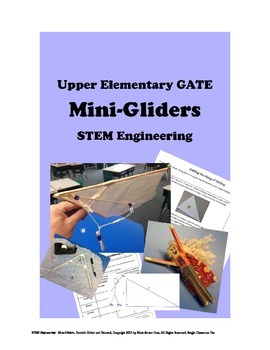STEM Kid Constructions MINI-GLIDER Upper Elementary GATE
Portable Gifted and Talented
3.1k Followers
Grade Levels
4th - 8th
Subjects
Resource Type
Standards
CCSS4.MD.A.2
CCSS5.MD.A.1
CCSS8.G.B.7
CCSS7.SP.C.6
CCSSRI.4.1
Formats Included
- Word Document File
Pages
23 pages
Portable Gifted and Talented
3.1k Followers
Description
Got a couple extra classroom hours? Kids bouncing off the walls eager for a vacation or a sunny day? . . . what to do? This!!!!
This STEM unit can go JUST A COUPLE HOURS OR SEVERAL HOURS—you choose.
Easily built inside two hours, these cool little mini-gliders fly very well. They’re about 100 steps up from any paper glider plans you might see, but you won’t have to break your piggy bank to purchase materials even for a large class.
Not just fun and games here: this little unit addresses ELEVEN (mostly 4th and 5th but an extension going up to 8th grade) Common Core State Standards in reading, writing, and math (plus Next Generation science).
Level: GATE 4-6th grades; 7th and 8th grades
Cost: less than 50 cents per student
Time: 2 to 6+ hours, depending on the depth this is taken
Included are plans to create and build the gliders, a non-fiction article about hang gliding with critical thinking questions, two math application activities to be used with the gliders, a creative extension project, Common Core State Standard references in reading, writing, and math where appropriate, and everything you’ll need to help you get ready to teach tomorrow.
On the other hand, if you want the jumbo, meter-wide (more complicated version) of this framed glider, check out “GR8 Glider Plans,” also available in my store.
This STEM unit can go JUST A COUPLE HOURS OR SEVERAL HOURS—you choose.
Easily built inside two hours, these cool little mini-gliders fly very well. They’re about 100 steps up from any paper glider plans you might see, but you won’t have to break your piggy bank to purchase materials even for a large class.
Not just fun and games here: this little unit addresses ELEVEN (mostly 4th and 5th but an extension going up to 8th grade) Common Core State Standards in reading, writing, and math (plus Next Generation science).
Level: GATE 4-6th grades; 7th and 8th grades
Cost: less than 50 cents per student
Time: 2 to 6+ hours, depending on the depth this is taken
Included are plans to create and build the gliders, a non-fiction article about hang gliding with critical thinking questions, two math application activities to be used with the gliders, a creative extension project, Common Core State Standard references in reading, writing, and math where appropriate, and everything you’ll need to help you get ready to teach tomorrow.
On the other hand, if you want the jumbo, meter-wide (more complicated version) of this framed glider, check out “GR8 Glider Plans,” also available in my store.
Total Pages
23 pages
Answer Key
Included
Teaching Duration
Other
Report this resource to TPT
Reported resources will be reviewed by our team. Report this resource to let us know if this resource violates TPT’s content guidelines.
Standards
to see state-specific standards (only available in the US).
CCSS4.MD.A.2
Use the four operations to solve word problems involving distances, intervals of time, liquid volumes, masses of objects, and money, including problems involving simple fractions or decimals, and problems that require expressing measurements given in a larger unit in terms of a smaller unit. Represent measurement quantities using diagrams such as number line diagrams that feature a measurement scale.
CCSS5.MD.A.1
Convert among different-sized standard measurement units within a given measurement system (e.g., convert 5 cm to 0.05 m), and use these conversions in solving multi-step, real world problems.
CCSS8.G.B.7
Apply the Pythagorean Theorem to determine unknown side lengths in right triangles in real-world and mathematical problems in two and three dimensions.
CCSS7.SP.C.6
Approximate the probability of a chance event by collecting data on the chance process that produces it and observing its long-run relative frequency, and predict the approximate relative frequency given the probability. For example, when rolling a number cube 600 times, predict that a 3 or 6 would be rolled roughly 200 times, but probably not exactly 200 times.
CCSSRI.4.1
Refer to details and examples in a text when explaining what the text says explicitly and when drawing inferences from the text.


